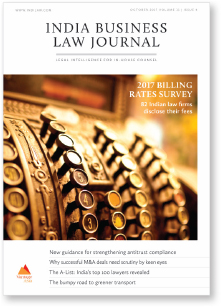Are there any downsides to differentiating only on fees?
“Complete carnage” was how cricketer Ben Stokes described the moment during a bidding war at the Indian Premier League (IPL) auction earlier this year, when a team that was last year’s bottom-ranked side paid seven times the asking price for him. A visibly surprised Stokes had emerged as the priciest player in the league, but not everyone shared his surprise. As the world’s most lucrative T20 league, the IPL is after all where cricketers make the biggest bucks – testament to the fact that talent follows money.

Yet fees matter and this month’s Cover story is our 11th annual survey of billing rates at law firms across India based on information sent to India Business Law Journal by the firms themselves. Our survey shows that hourly rates have fallen across the board. This is an inevitable consequence of the cut-throat competition among firms and demand for alternative fee structures from clients who increasingly call the shots. So, while Pravin Anand, the managing partner of Anand and Anand, speaks of “bespoke billing structures”, Anand Prasad, who moved out of Trilegal earlier this year, is less circumspect when he says he has “no definite fee structure”. The reality is that undercutting of fees is rampant and even when clients agree to a fee, obtaining payment is not easy.
The survey is our largest to date and is based on 82 participating firms of between three and 630 lawyers – including for the first time one of India’s top tier law firms, Cyril Amarchand Mangaldas – with offices in Ahmedabad, Bengaluru, Chandigarh, Chennai, Cochin, Delhi, Hyderabad, Kolkata and Mumbai. We highlight our findings through a series of infographics and present a table of billing rates here.
In The competition lawyer’s handbook we turn the spotlight on the Indian antitrust regulator’s first substantial guidance document, a 50-page compliance manual. It is expected to help companies implement the regulator’s earlier guidance – issued in a 2016 advocacy booklet on competition compliance programmes – that the existence of a strong compliance programme may help in arriving at reduced penalties in case of any violation, and we provide an analysis.
Writing in Vantage point, Girish Gadgil, legal head for the auto sector at Mahindra & Mahindra, says the Indian government’s recent push to adopt higher emission standards creates challenges. Gadgil argues that the recent decision to skip the Bharat stage V and move to the next stage of compliance from April 2020, could be very difficult to implement, given the stringent timelines and technological and commercial hurdles. As he points out the sector has already borne great financial losses on this count. The prohibition of sale of BS–III compliant vehicles with effect from 1 April 2017 gave auto manufacturers three days for disposal of already manufactured BS-III vehicles.
While factoring in risks such as this may be impossible, this issue’s What’s the deal, looks at how other risk factors can be identified. In An eye for a deal we detail key elements of a comprehensive due diligence exercise. Due diligence provides a vital means to gain knowledge about a target company in a limited time. The success of entire M&A deals hinges on this critical exercise.
For the second year running India Business Law Journal has compiled a list of India’s top lawyers. Honouring individual lawyers in this manner is useful and necessary given that the Indian legal market – unlike that in several other jurisdictions – is dominated by personalities and clients seek out individual lawyers, and not law firms, when they need legal counsel.
Our A-List of Indian lawyers consists of lawyers nominated by professionals at a wide range of Indian and international companies, law firms and other organizations. The lawyers on the list include the heads of several of India’s top law firms, including Zia Mody and Cyril Shroff. The list also includes less well-known lawyers such as Bhumesh Verma of Corp Comm Legal in New Delhi whom a Brazilian client describes as “hardworking, honest and agile with his deadlines”. Praise that could go a long way in an increasingly fee driven market.


























